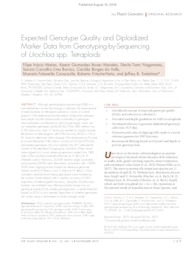Expected Genotype Quality and Diploidized Marker Data from Genotyping-by-Sequencing of Urochloa spp. Tetraploids.
Expected Genotype Quality and Diploidized Marker Data from Genotyping-by-Sequencing of Urochloa spp. Tetraploids.
Author(s): MEIRELES, K. G. X.; BARRIOS, S. C. L.
Summary: Although genotyping-by-sequencing (GBS) is a well-established marker technology in diploids, the development of best practices for tetraploid species is a topic of current research. We determined the theoretical relationship between read depth and the phred-scaled probability of genotype misclassification conditioned on the true genotype, which we call expected genotype quality (EGQ). If the GBS method has 0.5% allelic error, then 17 reads are needed to classify simplex tetraploids as heterozygous with 95% accuracy (EGQ = 13) vs. 61 reads to determine allele dosage. We developed an R script to convert tetraploid GBS data in variant call format (VCF) into diploidized genotype calls and applied it to 267 interspecific hybrids of the tetraploid forage grass Urochloa. When reads were aligned to a mock reference genome created from GBS data of the Urochloa brizantha (Hochst. ex A. Rich.) R. D. Webster cultivar Marandu, 25,678 biallelic single nucleotide polymorphism (SNPs) were discovered, compared with ~3000 SNPs when aligning to the closest true reference genomes, Setaria viridis (L.) P. Beauv. and S. italica (L.) P. Beauv. Crossvalidation revealed that missing genotypes were imputed by the random forest method with a median accuracy of 0.85 regardless of heterozygote frequency. Using the Urochloa spp. hybrids, we illustrated how filtering samples based only on genotype quality (GQ) creates genotype bias; a depth threshold based on EGQ is also needed regardless of whether genotypes are called using a diploidized or allele dosage model.
Publication year: 2019
Types of publication: Journal article
Unit: Embrapa Beef Cattle
Observation
Some of Embrapa's publications are published as ePub files. To read them, use or download one of the following free software options to your computer or mobile device. Android: Google Play Books; IOS: iBooks; Windows and Linux: Calibre.
Access other publications
Access the Agricultural Research Database (BDPA) to consult Embrapa's full library collection and records.
Visit Embrapa Bookstore to purchase books and other publications sold by Embrapa.

